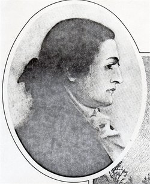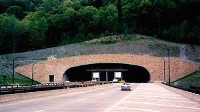The Cumberland Gap
The Cumberland Gap was a main point of travel through the Appalachian Mountains for a great many American settlers heading west in the late 18th and early 19th Centuries. 
One of only three passes through the imposing Appalachian chain, the Cumberland Gap was the product of natural forces during a period of centuries and was used by animals and Native Americans, Cherokee and Shawnee among them, long before English settlers arrived. As more and more people from England settled in to the North American colonies, they sought more and more opportunities to seek out new lands; in most cases, this meant heading west. 
Leading the first known explorers from what is now the United States through the Cumberland Gap was Dr. Thomas Walker a physician who had a knack for finding his way in the wild. Walker had heard stories of the Gap from Native Americans who lived nearby. Walker's party went through the Gap in 1750. He initially referred to it as the Cave Gap because it was near a cavern that they also explored. However, after he named a river just north of the gap the Cumberland River (after the Duke of Cumberland, the son of King George II and recent war hero), he thought it better to name the Gap after the Duke of Cumberland as well. The Cumberland Gap was not much more than a footpath when Walker's party went through it. The V-shaped Gap was certainly not fit for travel by goods-laden wagons. 
In 1775, the famed explorer Daniel Boone, who had first gone through the area six years earlier, led a party of woodsmen through the Gap, blazing what came to be called Boone's Road. They emerged into what is now Kentucky. A great many people would follow their lead, especially as Boone and others widened and otherwise improved the trail through the Gap. Travel to Kentucky and the Ohio Valley greatly increased. From 1775 to 1810, as many as 300,000 people traversed the Cumberland Gap, which eventually became part of the Wilderness Road. Once it was possible to drive wagons through the Gap, enterprising merchants loaded up wagons full of goods west, to facilitate commerce on the other side. Going the other way were settlers from Kentucky, driving cattle and horses back east for sale. The advent of the National Road in the 1830s made the Cumberland Gap less of a first choice for settlers heading west. Interest in the Gap peaked again during the Civil War, as Union and Confederate troops seized the Gap in turn; the Union occupation in 1863 was the last of the war. The introduction of regular rail travel further lessened travel through the Gap. It wasn't until the advent of the automobile, in the early 20th Century, that travel through the Gap picked up again. A 1908 road called the Government Pike ran through to Middlesboro, Ky. Nearby Lincoln Memorial University brought the Cumberland Gap in 1920 and then the Gap was the site for a federal highway. 
In modern times, the original Gap, now closed, is part of the Cumberland Gap National Historic Park, which contains 20,000 acres of scenery. A new highway wending through a 4,600-foot-long four-lane tunnel underneath the original Gap arrived in the 1990s. |
|
Social Studies for Kids
copyright 2002–2025
David White




